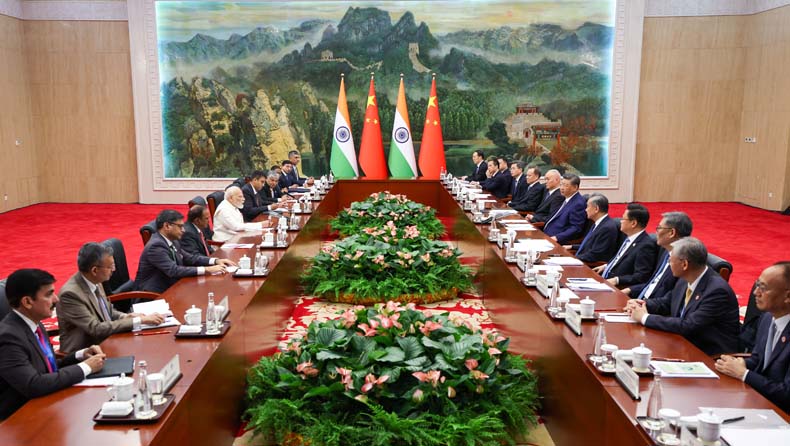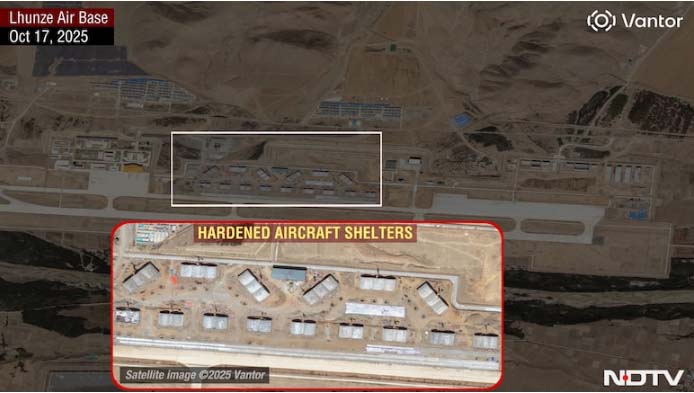As we see thaw set in at trade and political levels, on the ground around the Doklam area, China continues to build impressive infrastructure with a range of sophisticated weaponry. India is ramping up capacity to ensure corresponding capability. It’s not all quiet on ground – Editor
This offbeat article is intended to draw attention towards an aspect that has for long been away, from our main discourse, and that is how fast China is growing in our neighbourhood, that too along the Doklam area. China’s military build-up across the Tibetan Plateau has entered a new phase, extensive, multi-dimensional and opaque, more so, in the last few months and years. Once it was only limited to road and troop infrastructure, but it now extends to fortified airbases, missile storage facilities, heliports and underground command centres. The Western Theatre Command, responsible for operations against India, has witnessed the fastest peacetime expansion in recent Chinese military history.

Strategic Logic Behind the Buildup
This transformation aligns with Beijing’s evolving strategy of “active defence” and “buffer zone control.” Infrastructure once described as defensive, now serves coercive diplomacy. Roads linking Pangong Tso to the Sikkim frontier permit lateral troop and armour movement across sectors, letting the People’s Liberation Army (PLA) apply pressure simultaneously at multiple flashpoints.
China’s construction near Doklam, an area of strategic sensitivity for both India and Bhutan, strengthens its grip over ridgelines dominating the Siliguri Corridor, the narrow “Chicken’s Neck”, that connects India’s northeastern states with the rest of the country. Control or even the perception of dominance here, provides Beijing a psychological and strategic lever in crisis situations.

India’s Counter-Posture
India has moved decisively to neutralise this threat to some extent. The Rangpo–Nathula highway has been upgraded for all weather access, and new bridges across the Teesta River have improved mobility for both civilian and military logistics. The IAF and Indian Army now conduct joint patrols with the Royal Bhutan Army, enhancing coordination, transparency and deterrence in contested tracts.
At the same time, airbase expansions at Hasimara, Bagdogra and Pakyong have bolstered India’s eastern airpower footprint. Forward Advanced Landing Grounds (ALGs) such as Nyoma, Daulat Beg Oldie, and Pasighat are being upgraded to handle heavy lift and fighter operations. Together, these initiatives deny China any chance of a swift fait accompli and reinforce Bhutan’s faith in India’s security umbrella.

PLAAF–IAF Balance Across the Himalayas
While China’s Western Theatre Command enjoys numerical superiority, its operational geography is its greatest handicap. Most of its forward airbases Lhasa-Gonggar, Ngari -Gunsa, Shigatse, Hotan and Nyingchi are located at elevations exceeding 10,000 feet. The thin air drastically reduces engine thrust, aircraft payload and range by 30–40 percent.
In contrast, the Indian Air Force (IAF) operates from lower altitude bases such as Leh, Bareilly, Ambala, Hasimara and Tezpur. Aircraft can take off with full weapons and fuel loads and maintenance cycles remain shorter due to moderate climatic conditions. This difference in altitude alone gives the IAF a significant operational advantage.
The People’s Liberation Army Air Force (PLAAF) fields advanced platforms J-10C, J-11B, J-16, and limited numbers of the J-20 stealth fighter. Yet, the IAF’s Su-30MKI, Rafale, Mirage-2000, MiG-29UPG and LCA Tejas fleets provide a more balanced mix of versatility, range, and combat experience. The Rafale’s Spectra electronic warfare suite and Meteor BVRAAM missile effectively counter the J-20’s stealth edge.
Let’s have a look at some of the aerial assets that have been placed in this region. At Gonggar and Qüriqilin, China has permanently deployed J-20 stealth fighters, supported by J-10C and J-16 multirole jets, tactical UAVs and loitering munitions. These are protected by HQ-22 and S-300 derivative surface-to-air missile systems forming a multi-layered shield over the plateau. Newly built heliports at Dagzê and Nyingchi enable rapid deployment of attack and transport helicopters toward the Bhutan–Sikkim axis.
Satellite imagery confirms 36 hardened aircraft shelters at Lhunze, along with underground missile storage facilities overlooking the Chumbi Valley. The pattern suggests a deliberate shift toward concealed, high-readiness deployments forces that can be activated without overt mobilisation, maintaining ambiguity and surprise.

In Air Defence, China’s HQ-9 and HQ-22 systems form layered protection, but India’s S-400 Triumf, Akash NG, and Israeli Spyder batteries provide stronger integrated coverage across sensitive sectors. On the logistics side, the IAF’s C-17 Globemaster, C-130J Super Hercules, and Chinook fleets have proven their worth in high-altitude operations from Ladakh to the Northeast whereas PLAAF’s Y-20 transports face payload penalties on the plateau.
Situational awareness is near parity. The PLAAF employs KJ-500 and KJ-200 AEW&C systems, the IAF fields Phalcon AWACS and Netra platforms. However, India’s radar and sensor network, integrated through the Integrated Air Command and Control System (IACCS), offers superior real-time data fusion.
Crucially, IAF pilots possess far greater combat exposure from Kargil 1999 to Balakot 2019 and remain permanently deployed and acclimatised in high altitude conditions. PLAAF rotations, by contrast, result in limited terrain familiarity.
Reflecting this reality, the 2025 WDMMA Global Air Power Index ranks the Indian Air Force ahead of the PLAAF, underscoring India’s qualitative, doctrinal, and readiness superiority despite China’s numerical advantage. The overall balance thus tilts toward the IAF in any limited, high-altitude air confrontation along the Line of Actual Control (LAC).

Internal Turbulence Within the PLA
Even as Beijing projects strength abroad, cracks have appeared within its military establishment. Over the past year, nine PLA generals including senior officers from the Rocket Force and Western Theatre Command have been purged on charges ranging from corruption to “loss of political loyalty.”
This wave of dismissals, described by analysts as the largest military purge since the Cultural Revolution, points to deeper systemic insecurity. The Rocket Force, which manages China’s nuclear and long-range missile arsenal, saw its top leadership replaced almost overnight. The opacity surrounding their disappearance and subsequent arrests underscores President Xi Jinping’s growing mistrust of his own commanders.
For India, this internal turbulence has two implications. First, the PLA’s operational confidence may temporarily dip as new, politically loyal but less experienced officers take charge. Second, it reveals that Beijing’s command system remains highly centralised, with little institutional autonomy at theatre level limiting flexibility in fast-moving crises like the 2020 Ladakh standoff.
Intelligence reports also indicate a reorganisation of the Western Theatre Command, with an emphasis on tighter political oversight. Commanders are being rotated more frequently, and field-level decision-making is increasingly subject to approval from the Central Military Commission (CMC). While this ensures control, it also risks slower tactical response in a border escalation.

The 4th Plenum and Political Under-Currents
The Fourth Plenum of the 20th Central Committee, held in mid-2025, was expected to showcase political stability ahead of the 2027 Party Congress. Instead, it was overshadowed by intense speculation about leadership changes. Rumours swirled that Premier Li Qiang might be replaced following internal disagreements over economic management and the handling of youth unemployment, which has crossed 20 percent in urban centres.
Though the official communiqué reaffirmed Xi’s leadership, the unusually long delays in the Plenum’s announcement and the absence of key ministers pointed to factional jockeying within the Party. The persistent narrative of a “core leader” and renewed emphasis on ideological purity suggest that internal cohesion remains fragile.
For the military, such political tremors translate into heightened ideological drills and loyalty campaigns. Reports from Tibetan garrisons’ mention “political study sessions” now taking precedence over tactical training. This re-politicisation of the PLA mirrors Mao-era tendencies, when political reliability outweighed professional competence. For India’s planners, it signals both an opportunity and a risk an opponent that is politically constrained but still capable of unpredictable moves driven by regime insecurity.

Geopolitical Shifts: The Busan “G2” Moment
Amid this domestic flux, an event in Busan attracted global attention: the meeting between Donald Trump and Xi Jinping, marking what commentators have dubbed the birth of a new “G2 moment.” Both leaders, despite their contrasting styles, discussed resetting great-power relations to stabilise trade and reduce military friction.
While the “G2” label suggests a bipolar global order reminiscent of the US Soviet era, the context today is more complex. Xi sought economic relief through eased tariffs and tech access, whereas Trump returning to the global stage pursued transactional gains without abandoning strategic rivalry.
For India, the Busan dialogue carries mixed implications. A temporary thaw between Washington and Beijing could reduce external pressure on China, allowing it to refocus on its periphery, including the Himalayas. Yet, a stable US-China trade channel also gives India breathing space to strengthen its own industrial base and alliances like the Quad. The challenge for New Delhi lies in leveraging this window to deepen domestic defence production under ‘Make in India’ and expand high-technology partnerships.

The Broader Himalayan Equation
The Tibetan military build-up must therefore be read not in isolation but as part of a grander Chinese design linking continental assertiveness with global repositioning. The Western Theatre Command’s posture is calibrated to keep India militarily off-balance while maintaining plausible deniability.
However, India’s strategic responses have matured considerably since the 1962 debacle. From doctrinal shifts under the Integrated Defence Staff to the establishment of Integrated Battle Groups (IBGs) and upcoming theatre commands, India’s focus has moved from reaction to prevention.
The IAF’s readiness along the eastern and northern fronts, combined with real-time ISR integration and indigenous missile capability, has reshaped deterrence dynamics. The induction of the S-400, the success of Astra Mk-2 beyond-visual-range missiles, and expanded BrahMos-A deployment provide credible standoff capabilities against any trans-Himalayan threat.
Simultaneously, the Indian Army’s logistics reforms automated supply chains, forward fuel storage, and improved winter habitats have ensured sustained presence through harsh seasons. This multidomain readiness now acts as a stabiliser, reducing the incentive for Beijing to attempt localised border adventurism.

A Contest of Endurance and Perception
The contest between India and China along the Himalayas is as much about perception as capability. Beijing seeks to project inevitability an image of a rising power unchallenged on its periphery. New Delhi, through resilience and calibrated firmness, contests that narrative daily.
For all its investment in infrastructure, the PLA remains constrained by terrain, weather, and the human dimension of warfare. No amount of technology can fully offset the challenges of operating at 15,000 feet under unpredictable Himalayan conditions. India’s advantage lies in its experience its pilots, soldiers, and logisticians have lived and operated in these mountains for decades.
The future will hinge not merely on hardware but on systems integration, rapid decision-making, and political resolve. As both sides continue to build capabilities, deterrence will rest on clarity of intent and credibility of response.
Conclusion
China’s fortification of Tibet, its assertive presence in Bhutan’s periphery and its internal military purges collectively paint a picture of ambition tempered by anxiety. The ongoing modernisation of the PLAAF and infrastructure in Tibet underscores Beijing’s long-term intent to dominate the Himalayan front. Yet, the very geography of the region, coupled with India’s technological edge, operational flexibility, and human resilience, ensures a robust counterbalance.
India today is not the India of 1962. Its Air Force stands globally recognised ranked above the PLAAF in the latest WDMMA Index and its strategic partnerships, industrial capacity, and leadership confidence are on the rise. The challenge lies in sustaining momentum: building self-reliant capabilities, maintaining diplomatic agility, and preserving unity of purpose across the political-military spectrum.
The Himalayas have always been a theatre of endurance. In the coming years, they will also test the clarity, patience, and confidence of two ancient civilisations redefining their 21st-century destinies.
ABOUT THE AUTHOR
 Air Marshal (Dr) Sanjeev Kapoor (Retd) a pilot, with over 8000 hrs of flying. He is a flying instructor and a pioneer in aerial refuelling in IAF. He commanded the air-to-air refuelling squadron, a large operational base, Air Force Academy and National Defence Academy. He holds an Airline Pilot License and is part of various think tanks, boards and studies.
Air Marshal (Dr) Sanjeev Kapoor (Retd) a pilot, with over 8000 hrs of flying. He is a flying instructor and a pioneer in aerial refuelling in IAF. He commanded the air-to-air refuelling squadron, a large operational base, Air Force Academy and National Defence Academy. He holds an Airline Pilot License and is part of various think tanks, boards and studies.








